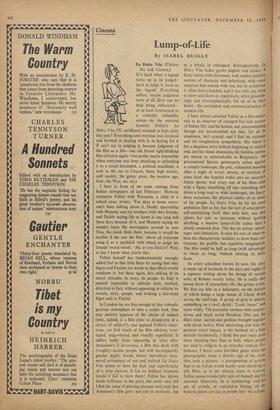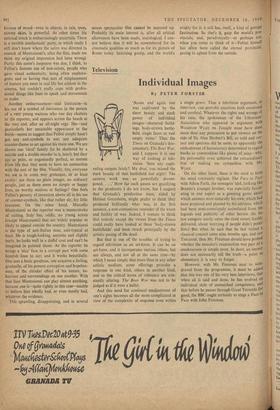Cinema
Lump-of-Life
By ISABEL QU1GLY IT'S hard when a legend turns up to be judged: hard to judge it, hard on the legend. Everything suffers, maybe judgment most of all. How can we help being influenced— or at least forewarned to a critically unhealthy extent—by the national hysteria Fellini's La Dolce Vita ('X' certificate) aroused in Italy early this year? Everything and everyone was involved and invoked in dealing with it, in feeling for it (I can't say in judging it, because judgment of the film as a fiim—our old friend right-thinking film criticism again—was pretty nearly impossible when everyone was busy attacking or defending it as a social document, a political manifesto, a sock in the eye to Church, State, high society, café society, the gutter press, the modern age, Italy, the West, etc. etc.).
I have in front of me some cuttings from Italian newspapers of last February : Moravia compares Fellini with Petronius, a child in a school essay writes: 'For days at home every- one's been talking about it, Daddy quarrelling with Mummy and my brothers with their friends, and Daddy saying life at home is one long hell these days because of it, and Mummy saying we mustn't leave the newspapers around in case Tina, the maid, finds them, because it would be terrible if she saw the film,' above all everyone using it as a yardstick with which to judge his friends' moral worth: 'Ali, so you liked it? Well, at last I know what you're like.'
Fellini himself has (understandably enough) added fuel to that little blaze by saying that only bigots and Fascists (or words to that effect) would condemn it; but there again, he's talking of its moral attitudes, its story, its people. In Italy it seemed impossible to criticise style, method, direction in fact, without appearing to criticise its morals, story, people, and looking a fair-sized bigot and/or Fascist.
In London we are free enough of this violently partisan atmosphere to take a cooler look. One may entirely approve of the choice of subject (who, indeed, is a film critic to disapprove of a choice of subject?), and applaud Fellini's inten- tions, yet find much of his film obvious, over- stated, long-winded, and visually superficial. It suffers badly from appearing so soon after Antonioni's L'Avventura, a film that deals with (roughly) similar people, but with incomparably greater depth; beside whose marvellous man- nered seriousness of eye and outlook La Dolce Vita seems to have the kick and superficiality of a strip cartoon. It has its brilliant moments (could it fail to have them? Fellini has shown much brilliance in the past), but never once did I feel the sense of piercing pleasure and truth that Antonioni's film gave, not just at moments, but as a whole, in retrospect. Retrospectively, La Dolce Vita fades, grows slighter and slicker. It fairly bursts with cleverness, with sudden intuitive notions of character and behaviour, with visual surprises that remain with one, but its symbolisnl is often heavy-handed, and it has only one thing to show and shows it, repetitively, often galumph- ingly and overemphatically, for all of its three hours: the corruption and commercialisation of modern life.
I have always admired Fellini as a film-maker and as an observer of cramped but rich corners of Italian life; and his honest, sad, uncommenting though not uncommitted eye that, for all its steadiness, isn't cynical; and I find his attitudes and his imagination sympathetic. His talent is for a shapeless story without beginning or explicit end, and his visual obsessions, his familiar scenes, are almost as unmistakable as Bergman's: the processional figures, grotesquely urban against a country landscape, the pale, exhausted morning after a night of terror, misery, or emotion Of some kind, the hopeful walks into an uncertain future (pretty well every one of his films ends with a figure shambling off into something new down a long road or wide landscape), the fana- dress occasions, the physical oddity of so manY of his people. La Dolce Vita, by far his most ambitious film so far, has the sort of amorphous, self-multiplying forth that suits him, one that allows for cuts or increases without spoiling anything, a massive lump-of-life rather than a closely analysed slice. This has its artistic advan- tages and limitations. It suits his sort of observa- tion, his characteristic inability to draw final con- elusions. his prolific but repetitive imagination. The film could be half as long (with advantage) or twice as long, without altering its basic form.
As every schoolboy knows by now, the story is made up of incidents in the days and nights of a reporter writing about the doings of various sorts of Roman society today. He is really that lowest form of journalistic life, the gossip writer. We first see him in a helicopter, on the bottom of which hangs a large statue of Christ, flying across the roof-tops. A group of girls in bikinis, sunbathing on a roof, shriek : 'Look, Jesus!' and wave wildly. The journalist answers with counter' waves and much aerial flirtation. This sets the film's tone: sacred and profane brought together with shock tactics. Most interesting, and with the greatest visual impact, is the incident of a fake miracle (incidentally, I think this part must seem more shocking here than in Italy, where people arc used to religion in an everyday context. for instance, I heard some horrified gasps when the photographer made a sketchy sign of the cross, then took a picture: a juxtaposition of actions that to an Italian would hardly seem shocking at all). Here, as in the miracle scene in Cabiria. Fellini seems wonderfully sure of himself and his material. Satirically, he is unfaltering; and his use of crowds, of cumulative feeling, of the hysteria latent not just in people but—by a trans' ference of mood—even in objects, in rain, trees, stormy skies, is powerful. At other times his satirical touch is embarrassingly uncertain. There is a terrible intellectuals' party, in which really I still don't know where the satire was directed (a remark of Mastroianni's, after the film, made me think my original impression had been wrong). Partly this scene's ineptness was due, I think, to Fellini's famous use of non-actors, people who gave visual authenticity, being often unphoto- genic and so having that sort of misplacement of feature you meet in real life but seldom in the cinema, but couldn't really cope with profes- sional things like lines to speak and movements to make.
Another embarrassment—and limitation—is his use of a symbol of innocence in the person of a very young waitress who one day chatters to the reporter, and appears across the beach at the very end, after an all-night orgy. She—and particularly her unsuitable appearance at the finish—seems to suggest that Fellini simply hasn't got any anti-symbols to use; any adequate counter-theme to set against his main one. We are shown one 'ideal' family (to be shattered by a suicide and a double murder in it, later); but they are so prim, so organisedly perfect, so remote from life that they seem to have no connection with the rest of the film. Visually, too, everyone we see is in some way grotesque, or at least exotic: are there no plain images, no ordinary people, just as there seem no simple or happy lives, no worthy motives or feelings? One feels Fellini's poverty of invention above all in his use of counter-symbols, like that rather sly, fey little innocent. On the other hand, Marcello Mastroianni as the reporter was a masterstroke of casting. Italy has, oddly, no young actors (except Mastroianni) that are widely popular or likely to appeal outside the country. Mastroianni is the type of anti-Italian man, anti-typical at least. He is tough-looking, amiable and slightly burly, he looks well in a duffel coat and can't be imagined in pointed shoes. As the reporter he brings a 'nice' face to a corrupt part with some fiendish lines to say; and it works beautifully. One sees a basic goodness, one acquires a feeling, gradually, of his present corruption and hopeless- ness, of the circular effect of his nature, be- haviour and surroundings on one another. With that face Mastroianni can play almost anything, because one is—quite rightly in this case—unable to believe him wholly bad, or even mostly bad, whatever the evidence.
This sprawling, disappointing, and in several senses spectacular film cannot be summed up. Probably its main interest is, after all critical allowances have been made, sociological. I can- not believe that it will be remembered for its cinematic qualities so much as for its picture of Rome today. Satirising gossip, and the world's avidity for it, it still has, itself, a kind of gossiPY fascination. So that's 4, gasp the world's pro- vincials; and, paradoxically—or perhaps not, when you come to think of it—Fellini himself has often been called the eternal provincial, gazing in aghast from the outside.



































 Previous page
Previous page